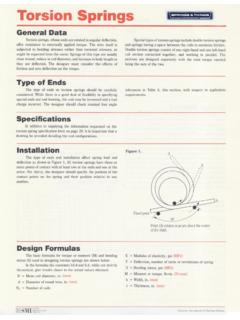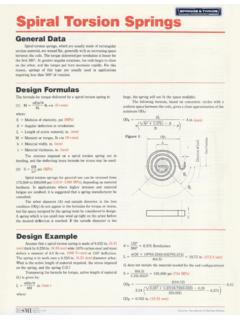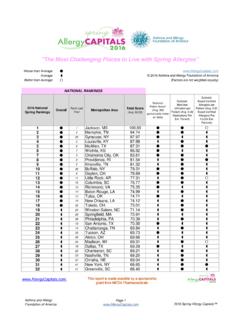Transcription of Data Sheets & Bulletin: Anderson Greenwood Direct …
1 Anderson Greenwood Direct spring OPERATED PRESSURE RELIEF VALVES. SERIES 60 AND 80. Premium performance Direct spring operated pressure relief valves that use special internals and soft seats to provide optimum, accurate performance FEATURES. Soft seat design provides repeatable bubble-tight performance before and after each relief cycle. Leak-tight performance near set pressure allows higher operating pressure, resulting in increased process throughput and system optimization. Easily replaceable soft seat and seals eliminate expensive, time-consuming lapping of metal components, resulting in lower long-term maintenance costs. Externally adjustable blowdown on Types 81/83 allows precise adjustment of reseat pressure without affecting set pressure adjustment. Blowdown can be adjusted with valve in service, helping eliminate the need for costly removal and/or system shut down. Types 81/83 provide full lift at set pressure with no overpressure required.
2 Minimizes possibility of freeze-up in applications Series 80 Series 60 involving a cryogenic or refrigerant and allows for applications to be set higher than Maximum Allowable Operating Pressure. GENERAL APPLICATION TECHNICAL DATA Type 81P spindle design balanced against the effects of back pressure without the use of a Specific valve types are available for gas, vapor, Sizes: x to 2 x 3 bellows, reducing both initial purchase and liquid; gas or liquid thermal relief, steam, (DN 15 to 50) associated long-term maintenance costs. cryogenic and chemically active applications. Orifices: to in2 Meet ASME Section VIII requirements, ( to cm2) providing the user with third party verification Connections: Threaded NPT, flanged of valve capacity and performance. Temperature range: -423 F to + 550 F Comply with the EC Pressure Equipment (-253 C to + 288 C) Directive 97/23/EC. Set pressures: 20 to 10,000 psig ( to barg). Code: ASME VIII.
3 2017 Emerson. All Rights Reserved. VCTDS-00544-EN 17/07. Anderson Greenwood Direct spring OPERATED PRESSURE RELIEF VALVES. SERIES 60 AND 80. CONTENTS MODELS OVERVIEW. Features and 1 Series 60. Selection Direct spring operated safety valves suitable Types 81, 3 - 5 for medium set pressure gas, vapor and liquid Type 6 - 7 or gas thermal relief applications. Brass Types construction offers an economical valve for carbon dioxide, natural gas and general gas or Sizing vapor services. How to size a valve ..9. Sizing formulas .. 10 - 13 Series 80. Physical properties .. 14 - 17 Direct spring operated safety valves suitable Conversion tables .. 18 - 19 for premium performance. They use special internals and soft seats to provide optimum, Ordering accurate performance. How to finalize your selection ..20. Pressure and temperature 21 - 23. Dimensions and weights .. 24 - 35. Materials of 36 - 40. 41 - 46. Accessories and options.
4 47. Additional information ..48. Model number selection table ..49. HOW TO SELECT A VALVE. Three steps make it easy to select, size and order the valve. Step 1: Preliminary valve selection: helps you determine the type of valve that best suits your application. Step 2: Sizing: provides the information you need to choose the correct valve orifice area. Step 3: Ordering: explains how to finalize valve selection and order the specific model number, after you have chosen the appropriate valve type and size. PRELIMINARY SELECTION GUIDE. Applications Relieving Balanced Valve Gas/ Gas/liquid Seat Body material Set pressure temperature for back type vapor Liquid thermal relief Steam type Brass CS SST psig [barg] F [ C] pressure 81 Plastic 50 to 10000 -423 F to 500 F N. [ to ] [-253 C to 260 C]. 81P Plastic 50 to 6000 -65 F to 400 F Y. [ to ] [-54 C to 205 C]. 83 O-ring 20 to 2000 -65 F to 550 F N. [ to ] [-54 C to 288 C].
5 63B O-ring 37 to 531 -65 F to 400 F N. [ to ] [-54 C to 205 C]. NOTE. 1. Minimum and maximum set pressures may not be available in all orifice sizes (see pages 21-23). 2. Anderson Greenwood Direct spring OPERATED PRESSURE RELIEF VALVES. SERIES 80. PRODUCT OVERVIEW. Types 81, 83 safety valves The Type 81 Direct spring operated safety valve, with an inert plastic seat, is suitable for a wide range of products, pressures and temperatures involving gas, vapor and liquid or gas thermal relief applications. It allows maintained tightness close to set pressure, opens fully at set pressure and provides a safe, external adjustment for short blowdown. The Type 81 valve is best suited for cryogenic, high set pressure and chemically active applications. The Type 83 Direct spring operated safety valve, with an elastomer seat, is ideal for gas processes that operate close to set pressure, for controlling valuable or polluting gas products that should not be lost to the atmosphere and for liquid or gas thermal relief applications.
6 It allows maintained tightness close to set pressure, opens fully at set pressure and provides a safe, external adjustment for short blowdown. The Type 83 is best suited for hard-to-hold gases and vapors and general gas or vapor service. The huddling chamber of all three valve types has been optimized to provide full opening at set pressure. In addition, there is a unique, independent control of the blowdown via an external adjustment screw. The huddling chamber is powerful enough to generate a lifting force to lift the disk (spindle) fully against the spring force, without any overpressure. Closing is assisted by the development of a controlled back pressure in the spring chamber. This unique design uses this controlled back pressure in the spring chamber to control precisely the magnitude of blowdown to a reasonable level. Sizes: x to 2 x 3 (DN 15 to 50). Orifices: to in2 ( to cm2). Connections: NPT, Flanged Temperature range: -423 F to + 550 F (-253 C to + 288 C).
7 Set pressures: 20 to 10,000 psig ( to barg). Code: ASME VIII. SEAT TIGHTNESS PERFORMANCE SPECIFICATIONS. All pressure relief valves are checked for seat leakage per procedures outlined in API 527. The following operating pressures will allow for bubble-tight seat sealing performance. Valve type Set pressure range Operating pressure range 81 and 83 100 psig [ barg] and above 0% to 95% of set 50 to 99 psig [ to barg] 0% to 90% of set Below 50 psig [ barg] 0% to 85% of set 3. Anderson Greenwood Direct spring OPERATED PRESSURE RELIEF VALVES. TYPES 81, 83 VALVE OPERATION. VALVE OPERATION. 1. System pressure is applied at the inlet to the seat area and exerts a force on the spindle. This upward force is counteracted by the downward force of the spring (Figure 1). While the system pressure is below set pressure, the pressure in the spring chamber, the inner chamber and the outlet is atmospheric (or uniformly exposed to the current superimposed back pressure, if any) (Figure 2).
8 2. A secondary orifice, consisting of two or more holes in the guide, permits gas discharge to the spring chamber when the valve opens. This orifice also functions to develop a back pressure in the spring chamber after valve actuation. If the system pressure increases to the point where the total upward force overcomes the spring force, the valve opens (Figure 3). 100% 100%. spring chamber 0% 0%. Secondary orifice Spindle Guide Seat Spindle skirt Inner chamber Outlet 100% 100%. 0% 0%. Inlet Figure 1 Figure 2 Figure 3. 4. Anderson Greenwood Direct spring OPERATED PRESSURE RELIEF VALVES. TYPES 81,83 VALVE OPERATION. 3. At set pressure, the initial flow across the seat is exposed to the additional area of the spindle skirt, which generates additional lifting forces. At this opening instant, the pressure in the inner chamber is greater than the pressure in the spring chamber, due to the restricted annular area between the spindle and the guide.
9 This increased force accelerates the spindle rapidly to its full open position (Figure 4). 4. After the spindle has lifted, a developed back pressure will be present in the spring chamber, due to the pressure drop across the secondary orifice. This pressure then acts down against the area of the spindle, as a supplemental force to assist the spring in closing the spindle (Figure 4). 5. This pressure can be adjusted externally with a threaded bolt, which partially restricts one of the guide holes, varying the amount of developed back pressure in the spring chamber (Figure 4) and controlling blowdown, independently of set pressure. Complete restriction of the flow through one of these guide holes by the blowdown adjustment will not affect capacity as the back pressure will never exceed 50% of the inlet pressure (Figure 4). 6. When the inlet (system) pressure drops to a level where the combined spring force and the developed back pressure on the spindle top overcomes the lifting force on the seat area, this causes the spindle to start down.
10 As soon as this happens, the pressure in the inner chamber is reduced instantaneously by a small amount. This increases the unbalance in a downward direction and the spindle accelerates downward, causing the valve to close with a snap action (Figure 5). 7. After valve reseating, residual pressure in the spring chamber immediately dissipates to the valve outlet, back to atmospheric pressure (or the current value of superimposed back pressure) and the valve is returned to its original state (Figure 6). 100% 100% 100%. 0% 0% 0%. Guide hole Blowdown adjustment bolt Blowdown 100% 100% 100%. 0% 0% 0%. Figure 4 Figure 5 Figure 6. 5. Anderson Greenwood Direct spring OPERATED PRESSURE RELIEF VALVES. SERIES 80. TYPE 81P RELIEF VALVE. The Type 81P is a soft-seated, balanced valve with an internal nozzle, guide and spindle assembly which are made especially for the unique demands of liquid service. Its spindle assembly uses three replaceable sealing members: a specially engineered plastic seat and two elastomer seals.
















